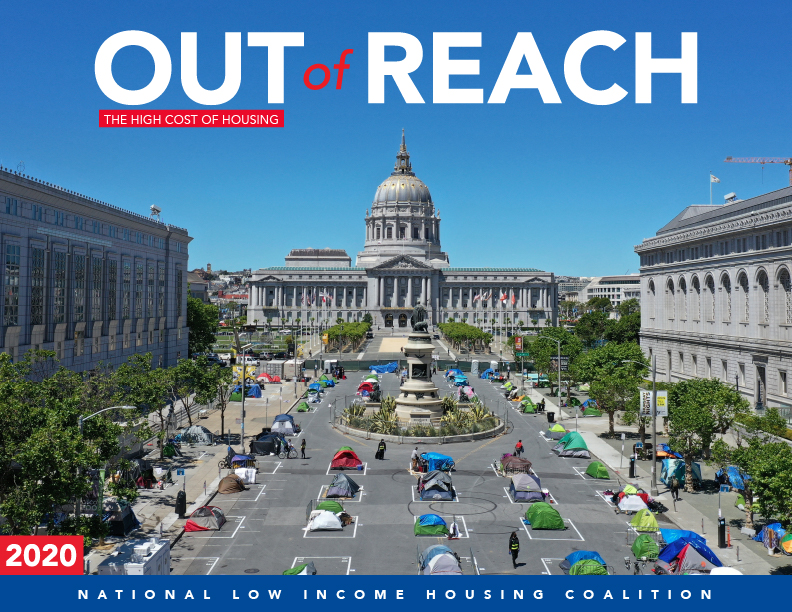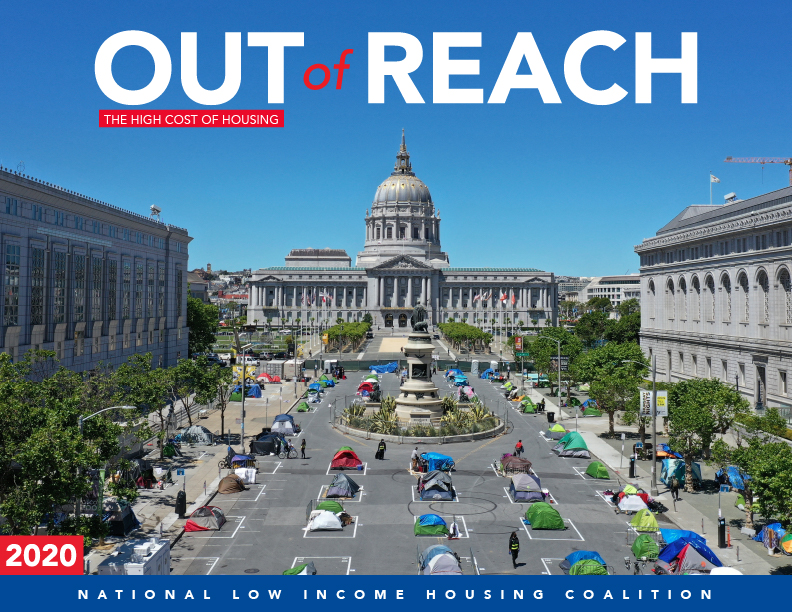NLIHC released Out of Reach: The High Cost of Housing 2020 on July 14. The report compares rents and wages nationally and in every state, country, and metropolitan area in the United States. Out of Reach 2020 shows that even before the onset of the COVID-19 public health and economic crisis, millions of workers were struggling to afford their homes. The report finds that both average renter wages and prevailing minimum wages are insufficient to afford modest rental apartments throughout the country. The report calls for emergency rental assistance in response to the pandemic and significant investments in the national Housing Trust Fund, Housing Choice Vouchers, and public housing.
Out of Reach uses the concept of a “housing wage,” or the hourly wage a full-time worker must earn to afford a modest rental home while spending no more than 30% of their income on rent and utilities. In 2020, the national two-bedroom housing wage is $23.96 per hour. On average, a household must have an annual income of at least $49,830 to afford a two-bedroom rental home at HUD’s average fair-market rent of $1,246 per month. The average hourly wage of renters in the U.S. is $18.22, $5.74 less than the two-bedroom housing wage.
The federal minimum wage is $16.71 less than the national two-bedroom housing wage. Even taking higher state and county minimum wages into account, the average full-time minimum wage earner would have to work approximately 97 hours per week for 52 weeks a year to afford a two-bedroom apartment, or 79 hours per week to afford a one-bedroom apartment at fair-market rent. In no state, metropolitan area, or county can a worker earning the federal minimum wage or prevailing state minimum wage afford a decent two-bedroom rental home at fair market rent by working a standard 40-hour week. In only 5% of counties nationwide can a full-time minimum-wage worker afford a one-bedroom apartment at fair-market rent.
Among states, the two-bedroom housing wage ranges from $14.19 in Arkansas to $38.76 in Hawaii. Hawaii, California, New York, Massachusetts, and the District of Columbia all have a housing wage of $30 per hour or higher. Twenty-two states and the District of Columbia have a housing wage higher than $20 per hour. The five metropolitan areas with the highest two-bedroom housing wages are San Francisco, CA ($64.21), San Jose-Sunnyvale-Santa Clara, CA ($57.12), Santa Cruz-Watsonville, CA ($48.44), Santa Maria-Santa Barbara, CA ($44.69), and Boston-Cambridge-Quincy, MA ($44.44).
Twelve of the twenty largest occupations in the country have median hourly wages that are below the one- and two-bedroom housing wages. Workers in these occupations account for more than 38% of the total U.S. workforce, excluding farmworkers. Food and beverage serving workers earn $11.24 an hour, retail sales workers earn $12.08, and home health aides earn $12.94, all less than the one-bedroom housing wage of $19.56. Many of these workers were laid off during the COVID-19 shutdowns, while others were deemed “essential workers” and asked to work in dangerous circumstances, despite not being paid enough to afford housing.
The lowest-income renters have the greatest challenge finding affordable housing. The national average fair market rent for a one-bedroom home is $1,017 per month and $1,246 for a two-bedroom home, far higher than the maximum $655 per month that family with income at the poverty level can afford. Seventy-one percent of extremely low-income renter households are severely housing cost-burdened, meaning they spend more than half of their income on housing, leaving few resources for other necessities and putting them at risk of losing their homes.
Racial and ethnic income inequality contributes to disparities in housing affordability. While the median White worker earns enough to afford a one-bedroom apartment at fair market rent, median Black and Latino workers do not. This income inequality partly explains why 44% of Black households and 42% of Latino households spend more than 30% of their incomes on housing, compared to 26% of White households.
The findings in Out of Reach 2020 demonstrate the large disparity between the incomes of low-wage workers and other vulnerable populations and the cost of modest rental homes. In response to the pandemic, lawmakers should secure emergency rental assistance to help keep families stably housed. A permanent solution to this affordability problem requires increased federal funding for key affordable housing programs like Housing Choice Vouchers, the national Housing Trust Fund, public housing, and project-based rental assistance. These critical programs serve as a safety net, providing stable, affordable homes for the lowest income households.
The full Out of Reach 2020 report as available at: http://reports.nlihc.org/oor

